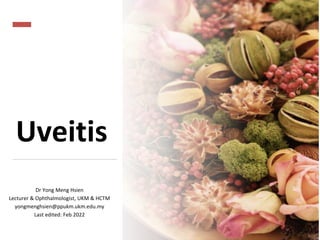The document is a detailed overview of uveitis, including its classification, causes, diagnostic approaches, and management strategies. It discusses the various types of uveitis based on etiology, anatomy, and clinical features, along with signs to identify and differentiate them. Additionally, it outlines complications associated with uveitis and emphasizes the need for systemic investigations, specifically highlighting the importance of syphilis testing in patients with uveitis.















































![Autoimmune
• In general, autoimmune diseases are
mediated by Th1, Th2, and Th17 cells.
• Th1- cell-mediated immunity, with interferon
(IFN)-[gamma] → tissue damage
• Th2- humoral-mediated immunity →
hypersensitivity through IL-4-mediated B-cell
recruitment.
• The role of Th17 cells and their production of
IL-17 ?unsure](https://image.slidesharecdn.com/uveitisymh-220227072133/85/Uveitis-Notes-48-320.jpg)







































































